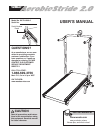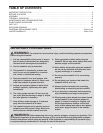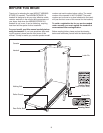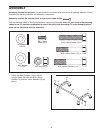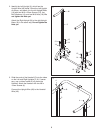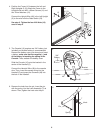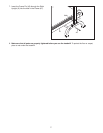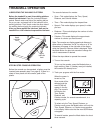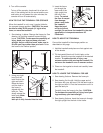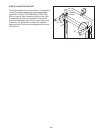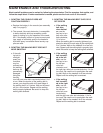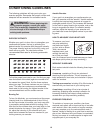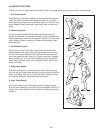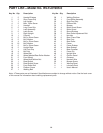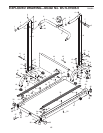
12
The following guidelines will help you to plan your
exercise program. Remember that proper nutrition and
adequate rest are essential for successful results.
EXERCISE INTENSITY
Whether your goal is to burn fat or to strengthen your
cardiovascular system, the key to achieving the
desired results is to exercise with the proper intensity.
The proper intensity level can be found by using your
heart rate as a guide. The chart below shows
recommended heart rates for fat burning and aerobic
exercise.
To find the proper heart rate for you, first find your age
near the bottom of the chart (ages are rounded off to
the nearest ten years). Next, find the three numbers
above your age. The three numbers are your “training
zone.” The lower two numbers are recommended
heart rates for fat burning; the highest number is the
recommended heart rate for aerobic exercise.
Burning Fat
T
o burn fat ef
fectively
, you must exercise at the proper
intensity level for a sustained period of time. During
the first few minutes of exercise, your body uses easi-
ly accessible
carbohydrate
calories for energy. Only
after the first few minutes does your body begin to use
stored
fat
calories for energy. If your goal is to burn
fat, adjust the intensity of your exercise until your
heart rate is between the lower two numbers in your
training zone as you exercise.
Aerobic Exercise
If your goal is to strengthen your cardiovascular sys-
tem, your exercise must be “aerobic.” Aerobic exercise
is activity that requires large amounts of oxygen for
prolonged periods of time. This increases the demand
on the heart to pump blood to the muscles, and on the
lungs to oxygenate the blood. For effective aerobic
exercise, adjust the intensity of your exercise until
your heart rate is near the highest number in your train-
ing zone.
HOW TO MEASURE YOUR HEART RATE
To measure your heart
rate, stop exercising
and place two fingers
on your wrist as shown.
Take a six-second
heartbeat count, and
multiply the result by
ten to find your heart
rate. (A six-second count is used because your heart
rate drops quickly when you stop exercising.)
WORKOUT GUIDELINES
Each workout should include the following three impor-
tant parts:
A warm-up, consisting of five to ten minutes of
stretching and light exercise. This will increase your
body temperature, heart rate, and circulation in prepa-
ration for exercise.
Training zone exercise, including 20 to 30 minutes of
exercise with your heart rate in your training zone.
A
cool-down
, consisting of five to ten minutes of
stretching. Stretching after exercise is effective for
increasing flexibility and helps to offset problems
caused when you stop exercising suddenly.
EXERCISE FREQUENCY
To maintain or improve your condition, plan three
workouts each week, with at least one day of rest after
each workout. After a few months of regular exercise,
you may complete up to five workouts each week, if
desired. Instead of waiting for a good time to exercise,
plan a time. Whatever time you choose, be consistent;
the key to success is to make exercise a regular and
enjoyable part of your everyday life.
CONDITIONING GUIDELINES
WARNING: Before beginning this
or any exercise program, consult your physi-
cian. This is especially important for individu-
als over the age of 35 or individuals with pre-
existing health problems.



